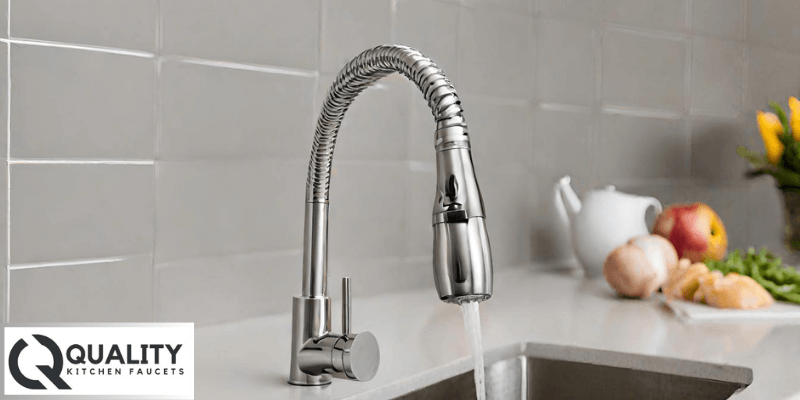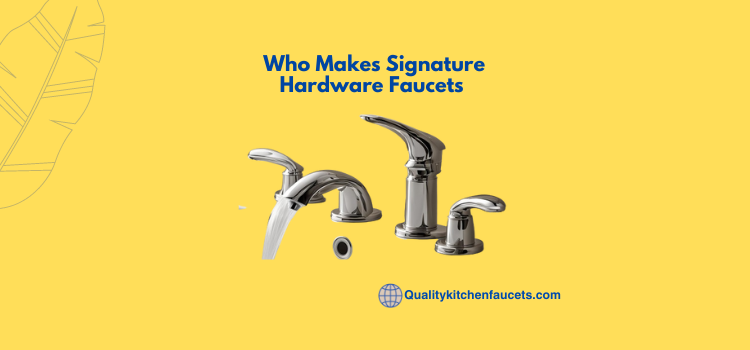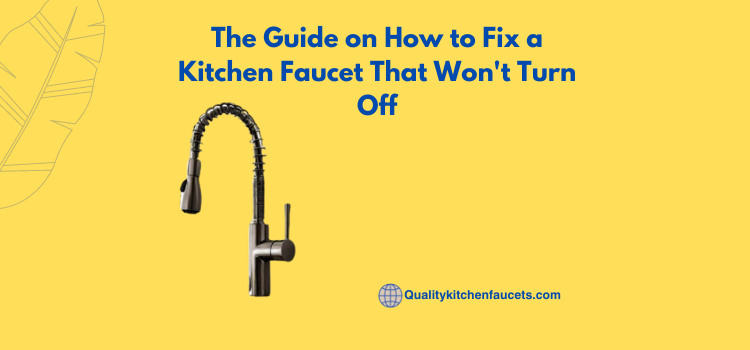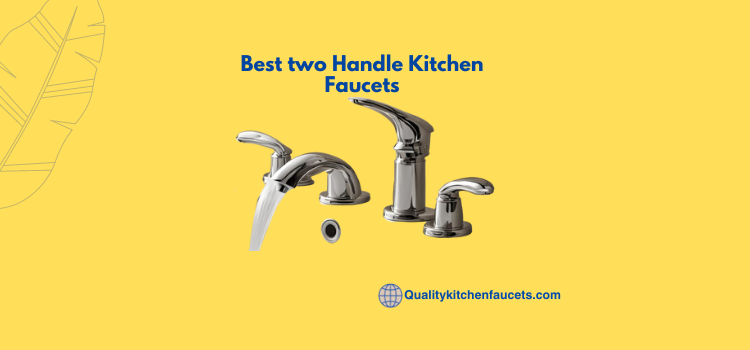How Long Does a Kitchen Faucet Last? in 9 Steps
While often overlooked, how long does a kitchen faucet last? Are indispensable in a well-functioning home. But have you ever wondered how long a sink tap lasts? Though seemingly simple.
Rather than waiting for a faucet to fail unexpectedly, wouldn’t it be better to anticipate its lifespan and plan a replacement? This article will guide you through the variables affecting the durability of your mixer tap and suggest ways to extend its longevity, saving you time, hassle, and potentially costly repairs.
So, whether you’re planning a kitchen renovation or simply curious about your faucet’s lifespan, continue reading about your kitchen fixture needs to ensure a well-maintained, efficient kitchen for years.

How Long Does a Kitchen Faucet Last? in 9 Steps
Step 1: How long can I expect my water spigot to function normally?
Brand and Quality: Do They Matter?
When contemplating the lifespan of a sink faucet, the brand and quality undeniably play a critical role. Faucets from reputable brands, constructed with high-quality materials, tend to outlast their cheaper counterparts.
These brands often use durable materials like stainless steel or brass, incorporating advanced technologies to reduce wear and tear.
Consequently, a high-quality kitchen tap from a reputable brand can last 15 to 20 years or even longer with proper care and maintenance.

Step 2: What factors can cause a sink tap to need replacing earlier than expected?
Usage and Maintenance: Key Aspects Affecting longevity
Just as with any home appliance, the duration of a mixer tap dramatically depends on its usage frequency and maintenance routine.
A frequently used and poorly maintained faucet may will undoubtedly require replacement sooner. On the other hand, regular deep cleaning and swift repairs of minor issues can extend the life expectancy of your faucet.
It’s important to note that even high-quality faucets can only degrade quickly if they are addressed. So, regardless of your faucet’s brand or quality, regular upkeep is essential for ensuring its longevity.
How can I tell if it’s time for a new kitchen faucet?
Signs Your sink faucet Needs Replacement
Several telltale signs indicate it may be time to replace your kitchen faucet. Despite attempts at repair, persistent leaks can tell that your faucet has reached the end of its useful life.
Moreover, visible corrosion or rust on your faucet, a loose or wobbly base, low water pressure, or constant drips even when the faucet is turned off are all signs that replacement may be necessary.
If your faucet is old and showing these symptoms.

Step3. What are some signs that a kitchen tap is nearing the end of its service life?
Age and Performance: The Indicators of Faucet Condition
As the faucet ages, components begin to wear out, and overall efficiency may start to diminish.
If your faucet is over 15 years old and you start to observe decreased performance or an increased need for repairs, it may be a sign that it is reaching its limit.
Remember, even the best brands and most durable materials have a finite longevity.
Step4. When should I consider upgrading to a new model for improved water efficiency or additional features?
Upgrading for Efficiency and Features: Timing is Everything
Consider an upgrade if your faucet still functions correctly but lacks modern features or energy efficiency.
Faucets designed in the last few years have advanced features like touchless operation, water filtration systems, and pull-down sprayers that make kitchen chores more straightforward and efficient.
Additionally, newer models are typically designed to be more water-efficient, which can reduce your environmental footprint and lower your water bills.
If these benefits align with your needs and values, consider replacing your old faucet even before it ends its life.
Step5. What type of sink tap design lasts the longest with proper care and maintenance?
Design and Longevity: The Winning Combination
When it comes to kitchen faucets, the design does matter for durability and longevity. Single-handle faucets, for instance, tend to have a longer life with proper care and maintenance.
However, regardless of the design, regular maintenance and timely repair of minor issues remain crucial to extending the life of your mixer tap.
Step6: What maintenance tasks can help extend the life of my existing sink faucet?
Maintenance Essentials: Prolonging Faucet
Using a mild, non-abrasive cleaner for routine cleaning is highly recommended to avoid damaging the faucet’s finish. Also, please check for leaks regularly and fix them immediately.
Small leaks can quickly become more significant problems if not addressed in time. Lubricating moving parts of the faucet, like the handle and the spout, can also help prevent wear and tear.
Remember, preventative maintenance can save you the cost and effort of replacing your kitchen tap prematurely.
Step 7. How do I know if a problem requires replacement or if a simple repair kit may solve the issue?
Distinguishing Repairs from Replacement: Knowing When It’s Time
While some issues with your sink tap may be resolved with a simple repair kit, others may necessitate a total replacement.
Typically, minor problems like a dripping faucet, loose handles, or low water pressure can often be fixed with the help of a repair kit.
However, if your faucet has persistent leaks after repeated attempts at repair, shows signs of severe corrosion or rust, or experiences multiple simultaneous issues, it is best to replace it. Remember, sometimes repeated repairs can outweigh the cost of a new faucet.
Always consult a professional plumber if you need clarification on whether a repair or replacement is proper.
Step 8: Is repairing an older water spigot worth it, or is replacement typically more cost-effective?
Assessing Worth: Repair Vs. Replacement for Older Kitchen Faucets
Several factors come into play in assessing the worth of repairing an older kitchen faucet versus a replacement.
If the faucet is of a high-end brand and the repair is minor, it might be more cost-effective to opt for a repair. However, numerous repairs could outweigh the cost of a new, more efficient model if your faucet shows multiple signs of wear, such as significant rusting, persistent leakage, or reduced water pressure.
You should also consider the faucet’s age; if it’s over 15 years old, replacement might be a more economical option in the long run.
Functionality and the potential benefits of modern, efficient models.
Step9. What should I look for in a new kitchen faucet to ensure it stands the test of time?
Looking Ahead: Qualities for a Long-Lasting Kitchen Faucet
It is longevity when shopping for a new kitchen faucet.
Firstly.
Secondly, could you consider the design of the faucet? Models with fewer moving parts or ceramic disk valves tend to last longer. Thirdly, look for features that match your needs, such as water-efficient designs or touchless operation, which can increase the faucet’s usability and longevity.
Lastly, could you consider the warranty offered by the manufacturer? A long-term warranty indicates confidence in the product’s durability and can provide peace of mind about your investment.
Remember, a well-chosen kitchen faucet can stand the test of time, add value to your kitchen, and serve you efficiently for years.
Conclusion
In conclusion, the materials’ service life, water quality, and maintenance.
However, on average, a well-maintained kitchen faucet can last 10–20 years.
This may seem like a long time, but think about the daily wear and tear your faucet endures—turning it on and off multiple times every day and exposure to different temperatures and chemicals.
It is an essential element in our homes that we often take for granted. Now that you know how long a kitchen faucet can last and the factors that affect its life expectancy, it is essential to keep up with regular maintenance and consider upgrading to higher-quality materials if you want your faucet to last longer.
Be proactive and save time and money in the long run before your old faucet starts leaking or causing other issues.
Remember, prevention is always better than cure! And with a well-functioning faucet, cooking and cleaning in the kitchen will be easier and more enjoyable.
So go ahead and give your faucet some love and attention; it will thank you for lasting for years to come! Do you have any tips or tricks on extending the duration of a kitchen faucet? Could you share them in the comments below? Let’s help each other make our faucets last even longer!
FAQs
How do I know if the faucet cartridge could be better?
Faucet cartridges can display signs of damage through persistent dripping, difficulty turning the handle, or inconsistent water temperature.
What wears out on a faucet cartridge?
Typically, the seals and O-rings within a faucet cartridge wear out, causing leaks or handling difficulties.
Are ceramic faucet cartridges better?
Yes, ceramic faucet cartridges are generally better because they are durable, provide a tight seal, and resist wear and corrosion.
Why do faucet cartridges fail?
Faucet cartridges often fail due to prolonged use, accumulation of hard water deposits, or wear and tear of internal components such as seals and O-rings.







